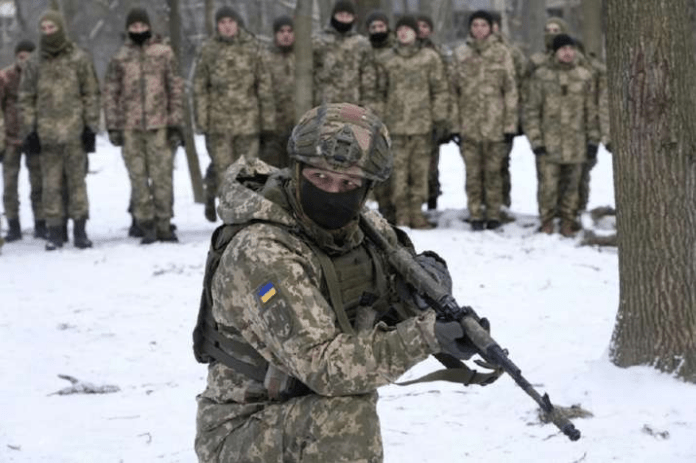| Translate This News In |
|---|
The Pentagon raised the alert level for 8,500 troops on Monday, preparing to deploy to Europe as part of a NATO “reaction force” amid mounting fears that Russia may intervene militarily in Ukraine. President Joe Biden spoke with important European leaders, emphasising the United States’ commitment to its partners in Europe.
Putting US forces on high alert for Europe signalled that Biden was losing hope that Russian President Vladimir Putin would back down from what he described as a threat to invade neighbouring Ukraine.
Beyond Ukraine’s future, the credibility of a NATO alliance that is crucial to US military strategy but Putin regards as a Cold War relic and a threat to Russian security is at stake. The situation will put Biden’s ability to rally allies against Putin to the test.
According to Pentagon spokesman John Kirby, about 8,500 US troops are on alert for possible deployment — not to Ukraine, but to NATO territory in Eastern Europe as part of an alliance force aimed to indicate a cohesive commitment to prevent any larger Putin assault.
Russia rejects any invasion plans. It claims that the accusations levelled by the West are really a pretext for NATO’s own planned provocations. High-stakes diplomacy has failed to yield any results in recent days, and key participants in the drama are making steps that indicate a dread of impending war. Biden has attempted to find a balance between steps intended to dissuade Putin and those that could give Putin an opening to utilise the massive force he has amassed on Ukraine’s border.
Biden had an 80-minute video conversation with other European leaders about Russia’s military buildup and possible invasion reactions.
At the White House, Biden told reporters, “I had a very, very, very nice meeting — absolute unanimity with all of the European leaders.” “We’ll discuss it later,” says the speaker.
The State Department had ordered all American personnel in the US Embassy in Kyiv to leave the country the day before, and said that non-essential embassy staff might leave at US government cost.
Oleg Nikolenko, a spokesperson for Ukraine’s Foreign Ministry, called the US decision “premature” and a sign of “overconfidence.” He claimed that in order to destabilise Ukraine, Russia was creating panic among Ukrainians and foreigners.
The United Kingdom announced that it, too, was removing some diplomats and their dependents from its Kyiv embassy. “The intelligence is pretty dismal,” Prime Minister Boris Johnson said, adding that an invasion was not inevitable.
Ordering even a small number of American troops to be ready for possible deployment to Europe is intended to emphasise the United States’ commitment to supporting NATO partners, particularly those in Eastern Europe who feel threatened by Russia and fear that Putin would target them.
“What this is about is reassurance to our NATO partners,” Kirby said at a Pentagon news conference, stressing that no troops will be deployed to Ukraine, which is not a member of NATO but has been promised of continuous US political backing and arms supply by Washington.
The Pentagon’s decision, which was taken at Biden’s request and on Defense Secretary Lloyd Austin’s advice, coincides with other NATO member governments’ efforts to strengthen a defensive presence in Eastern Europe. Denmark, for example, is dispatching a frigate and F-16 fighter jets to Lithuania; Spain is dispatching four fighter jets to Bulgaria and three ships to the Black Sea to reinforce NATO naval forces; and France is preparing to dispatch troops to Romania.
NATO has yet to decide whether or not to activate the Response Force, which is made up of 40,000 troops from a variety of countries. In 2014, when Russia invaded Ukraine’s Crimea Peninsula and intervened in eastern Ukraine in support of pro-Russian separatists, the Response Force was strengthened with the creation of a “spearhead force” of around 20,000 men on extra-high alert.
The US will contribute a variety of military forces if NATO decides to activate the Response Force, according to Kirby.
Some units will be ordered to be ready to deploy in as short as five days, according to him. He said an undefined number of the 8,500 troops might be deployed to Europe for tasks other than aiding the NATO Response Force. He indicated they might be used “if other situations occur,” but he didn’t give any more information.
Russia has gathered an estimated 100,000 troops along Ukraine’s border, demanding that NATO guarantee that Ukraine would never be admitted and that other moves, such as stationing alliance forces in former Soviet bloc nations, be stopped.
NATO announced on Monday that it is increasing its Baltic Sea deterrence.
Secretary-General Jens Stoltenberg stated that the alliance will “take all necessary steps to protect and defend all allies.” “Any degradation of our security environment will always be met with a response, including the strengthening of our collective defence.”
“All of this is happening because of what Russia is doing, not because of what we are doing.” “What NATO and the US are doing is causing this,” Peskov told reporters.
The EU has sped its penalty preparations, according to the ministers, who also warned that “any further military aggression by Russia against Ukraine will have significant consequences and terrible costs.”


















